Black & Yellow Striped Insects In Ohio: A Comprehensive Guide
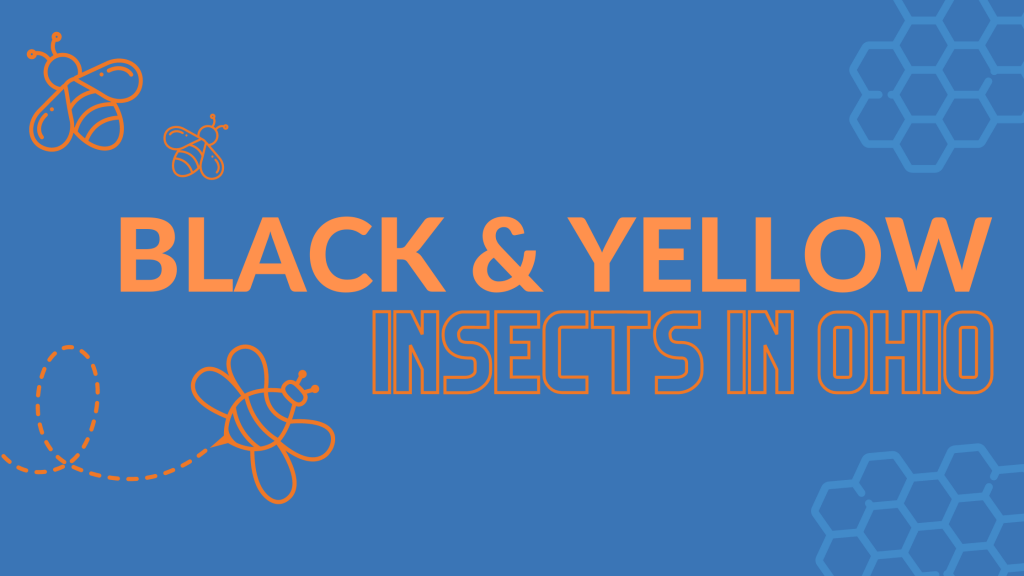
Updated on September 14th, 2023
What’s that black and yellow striped insect? Does it bite or sting? We’re glad you asked! Find out more about black and yellow striped insects in Ohio by reading our comprehensive guide below.
Carpenter Bees
Relatively harmless, carpenter bees are considered more of a nuisance pest than a dangerous one. Carpenter bees get their name from the female carpenter bees’ habit of drilling holes into wood to create nests where they’ll lay their eggs.
They don’t consume the wood they drill through; instead they actually feed on pollen and nectar, making them beneficial plant pollinators. You may actually mistake carpenter bees for bumblebees as they buzz around your garden from flower to flower during early spring and summer months!
The biggest problem with carpenter bees is that they often bore into man-made structures, such as fences or porches and along the sides of homes, garages, or sheds; which can lead to significant property damage. Their tunneling can be destructive and should be addressed as soon as possible to avoid extensive, costly damage.
What do they look like?
Carpenter bees are similar in size and appearance to bumble bees. The biggest differentiator between the two is that carpenter bees have noticeably smooth, shiny black abdomens, while bumble bees are entirely fuzzy all-around.
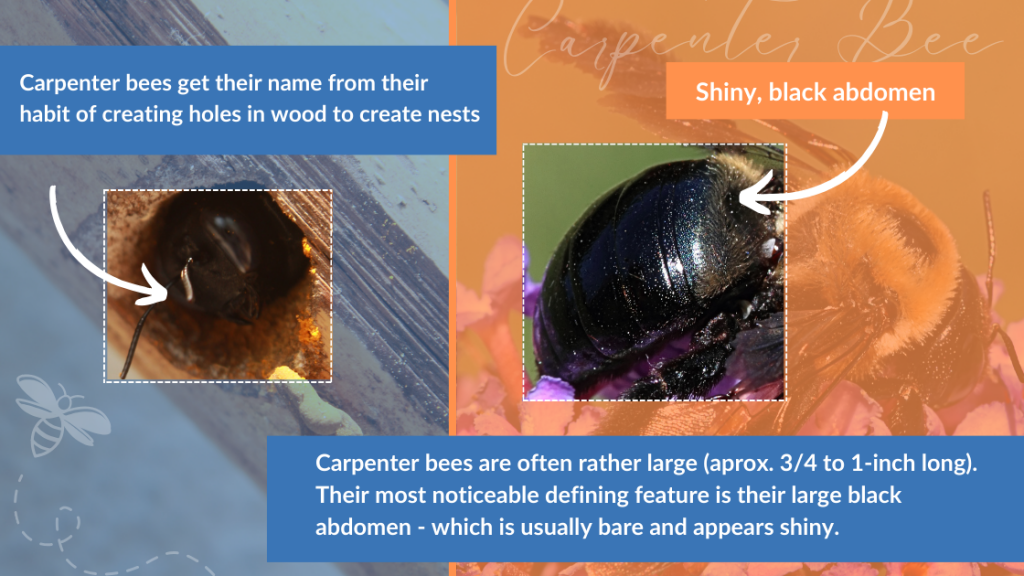
Do they sting?
The short answer: Yes, the females do (rarely!)
Male carpenter bees don’t have stingers but their primary job is to protect the nests. You’ll often notice they act tough, buzzing aggressively around you if you get too close to the location of a nest, but that’s all it is – an act. Usually you can just swat them out of the way!
Female carpenter bees, on the other hand, can sting but it’s quite rare for them to do so. They’ll typically only attack if they or the home they’re actively building is threatened.
Honey Bees
Honey bees are incredibly important pollinators for flowers, fruits, and vegetables! They help these plants grow and should be looked at as friends not foes.
They’re social insects that live in colonies that consist of a queen, a few hundred male drones, and thousands of female worker bees. The honey bees that you’ll often see buzzing about in your garden or outdoors near vegetation are the worker bees gathering nectar and pollen to bring back to their colonies for the developing brood.
What do they look like?
Honey bees typically have a warm, amber-brown coloration. They have a striped abdomen and are smooth, not fuzzy like bumble bees. A defining feature of honey bees is that they have more of a “heart-shaped” face than other bees.

Do they sting?
The short answer: Yes, but they’re not considered aggressive and can only sting once
If honey bees feel threatened, they will sting! Their stingers are barbed and will usually dislodge once the honey bee attacks so they often just sting once. Sometimes the stinger does not detach right away so they are capable of stinging again if that happens.
Honey bee stings can be quite painful and even life threatening to a small percentage of people who are allergic to their venom.
Bumblebees
Bumblebees are also important pollinators, especially to wildflowers and crops. Similar to honey bees, bumblebees live socially with queen bees, drones, and worker bees that all have specific tasks to help support their colonies.
Unlike honey bees, which have a perennial colony that survives continually from year to year, a bumble bee colony is only active for a single year at a time. New colonies are formed each spring by a new queen bumble bee. In early spring, the new bumble bee queen must find a new home to start this colony. They will usually find refuge in abandoned rodent burrows, holes in the ground, straw or hay bales, unturned compost piles, upside-down planters, at the base of tall grass, in bird houses or unkept feeders, or in crevices along stone retaining walls.
Something particularly interesting about bumblebee activity is that unlike other bees, they’re capable of foraging for food in cool, wet conditions and low light. This enables them to act as pollinators for plants that grow in the very early spring months and plants that thrive in shade.
What do they look like?
Bumblebees are most often confused with carpenter bees (and vice versa), particularly in the spring when both species are active and similar sized.
Bumblebees, however, are usually identifiable by the fact that they’re entirely fuzzy all around. They’ll have hairy abdomens, usually with a yellow band near the end.
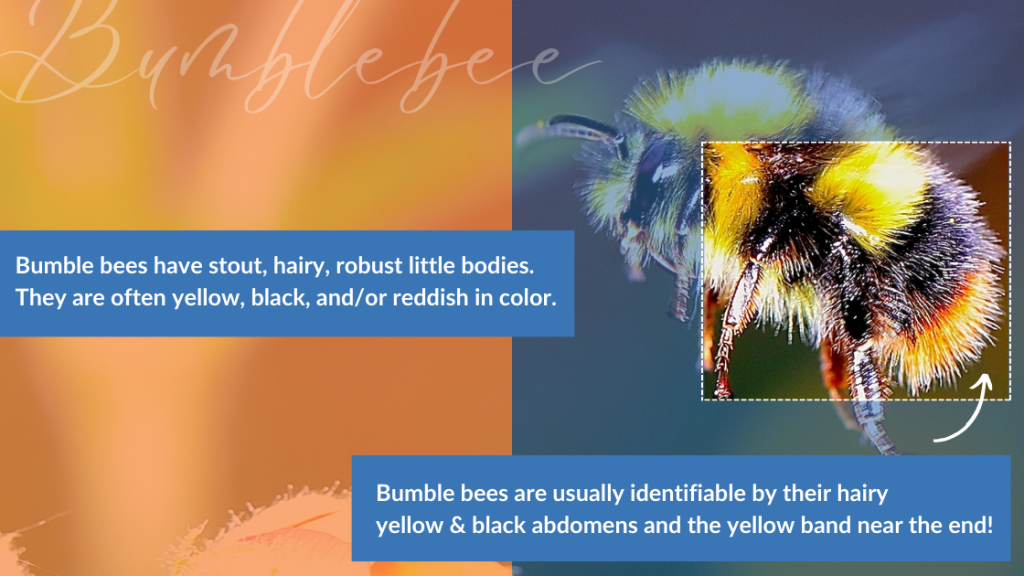
Do they sting?
The short answer: Yes, but they’re not aggressive and very rarely will someone have an allergic reaction to their stings
Unlike honey bees, bumblebees are able to sting multiple times because their stingers don’t detach.
Hoverflies
Hoverflies are actually flies that just look like bees and wasps. These black and yellow striped insects use their coloring as a disguise to help protect them from predators like spiders and other predators.
Hoverflies are black and yellow striped insects that should be especially welcome in your garden as they eat aphids and can help protect plants. Female hoverflies will actually seek to lay their eggs on plants that contain aphids. After a few days, the eggs hatch and larvae emerge to feed on the aphids. A single hoverfly larva can eat up to 30 aphids a day!
What do they look like?
Hoverflies are usually black with bands or stripes of yellow, white, and/or orange, resembling bees or wasps. Hoverflies have 1 set of wings (2 wings total), unlike bees and wasps – which typically have 2 pairs (4 wings total). Another defining feature of hoverflies is that they have large “fly eyes” that cover most of their face. They have the face of a fly and body of a bee.

Do they sting?
The short answer: Nope!
Hoverflies are harmless to humans.
Paper Wasps
Paper wasps are actually an invasive species of wasp originally from Europe. They were first identified in North America in the 1970s near Boston, MA and can now be found throughout most of the US and Canada, including down here in Ohio!
They tend to build their nests inside railings, mailboxes, and in and around buildings and other man-made structures so people often accidentally come across their nests, prompting the wasps to attack.
Paper wasps do serve a purpose as plant pollinators but they’re also considered a dangerous nuisance pest.
What do they look like?
Paper wasps have slender, segmented bodies with a distinct thin, hourglass-shaped waist. They are similar in appearance and commonly mistaken for yellow jackets, but yellow jackets often have a more compact body form and the hind legs of paper wasps tend to trail below them when they’re in flight. Paper wasps also typically have orange-tipped antennae (not black).
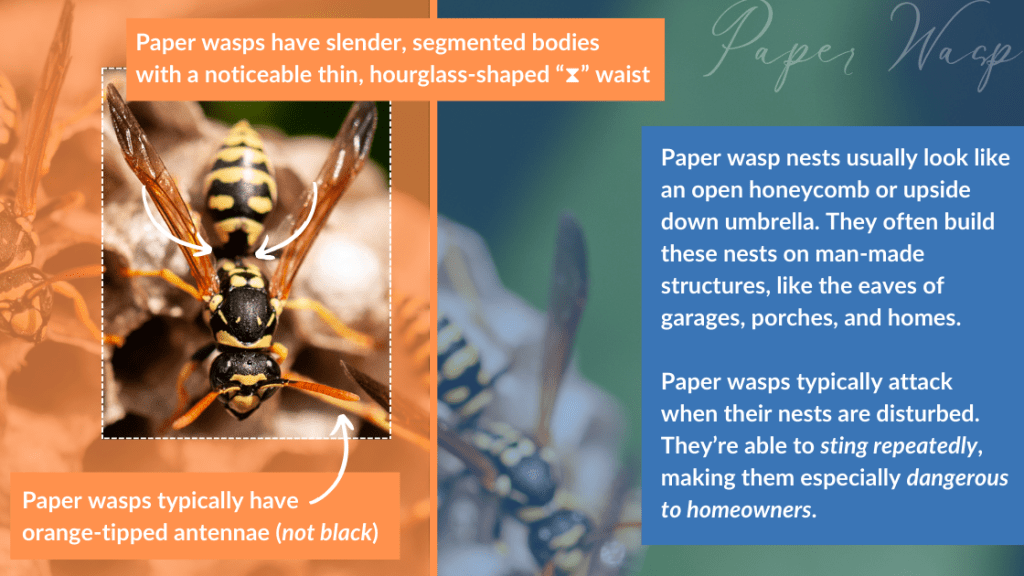
Do they sting?
The short answer: Yes, repeatedly.
European paper wasps can be very aggressive. They’ll most often attack when their nests are directly disturbed but can also be provoked if people or pets are simply too close. A paper wasp nest should be carefully removed if found near your home, as soon as possible. A pest control professional, like Go2-Pros extermination, can help ensure the safe removal of these nests to ensure the wasps don’t harm you and your family members.
Mud Dauber
Mud daubers are a type of wasp most notable for the nests they build out of mud. They usually build these nests in sheltered places, often favoring spots under or inside man-made structures like under eaves, porch ceilings, within garages and sheds that have been left open, or inside of barns, building walls, and attics.
Unlike many wasps, mud daubers are solitary creatures, meaning they aren’t social and don’t live together in large colonies.
What do they look like?
Mud daubers are usually identifiable by their “thread-waisted” bodies, having a noticeable long, slender “thread-thin” segment between their thorax and abdomen. They are usually mostly black in color but may also have pale yellow markings or an almost blue metallic shine. Their wings are usually clear or dark.
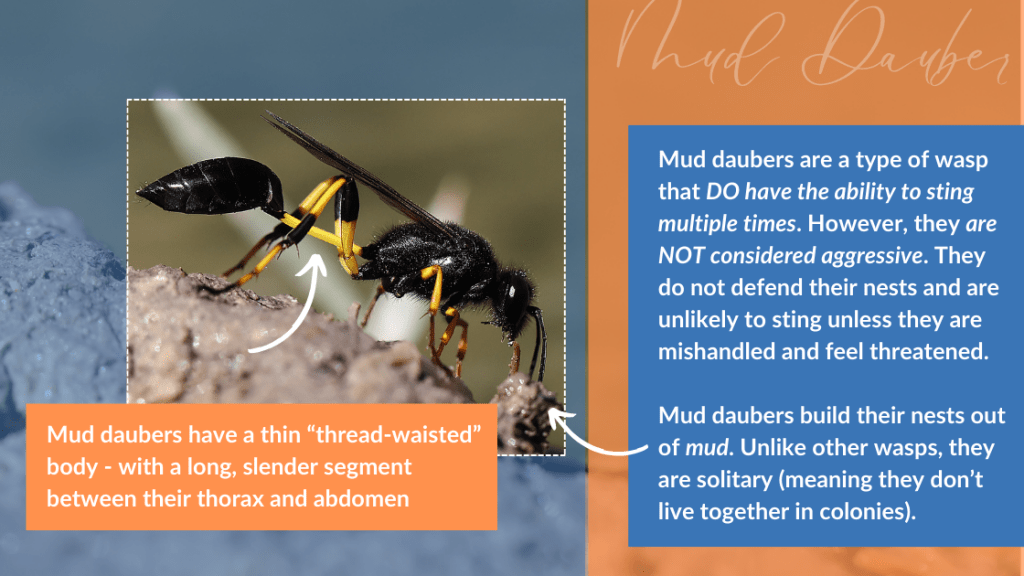
Do they sting?
The short answer: Rarely.
Mud daubers are unique in that they don’t defend their nests and aren’t considered aggressive. They’re more of a nuisance pest, not a dangerous one.
The biggest problem with mud daubers is that because they don’t defend their nests, other more dangerous wasp species will often overtake them. This means you should be extra cautious when you come across a mud dauber nest. A sign that a nest may be housing other types of wasps is if it has holes, as mud dauber wasps create holes when they emerge and leave their nests. A licensed pest control professional, like Go2-Pros, can safely handle mud dauber nest removal to ensure your safety.

Yellow Jackets
Yellow jackets, like paper wasps, create paper nests out of a mixture of chewed up cellulose and saliva. Their nests can be found underground but as they are opportunistic insects, you may stumble upon a nest in hidden places like under a deck or porch or inside of a building behind walls or even in attic spaces.
Yellow jackets do serve a purpose as pollinators but are mostly known for being predators that prey upon other insects. While caterpillars, grubs, and flies are their primary sources of food, yellow jackets will seek out other types of sweets and proteins, such as human food and open drink containers – making them a major nuisance pest!
What do they look like?
Yellow jackets are typically about ½” long with black and yellow stripes on their abdomens. Yellow jackets have more definitive markings, including black abdominal spots, 4 yellow thorax spots, a rear black diamond shape, and yellow stripes behind each eye. The dots on their abdomen are often a clear indicator that it’s a yellow jacket you’re dealing with.
Worker yellow jackets are most often confused for honey bees. Honey bees will typically be hairier with flatter hairy hind legs, which they use to carry pollen. Yellow jackets, by contrast, tend to have hard, shiny, and mostly hairless bodies. They may appear to have hair on their upper thorax but their abdomens and legs will be entirely hairless, unlike a honey bee.
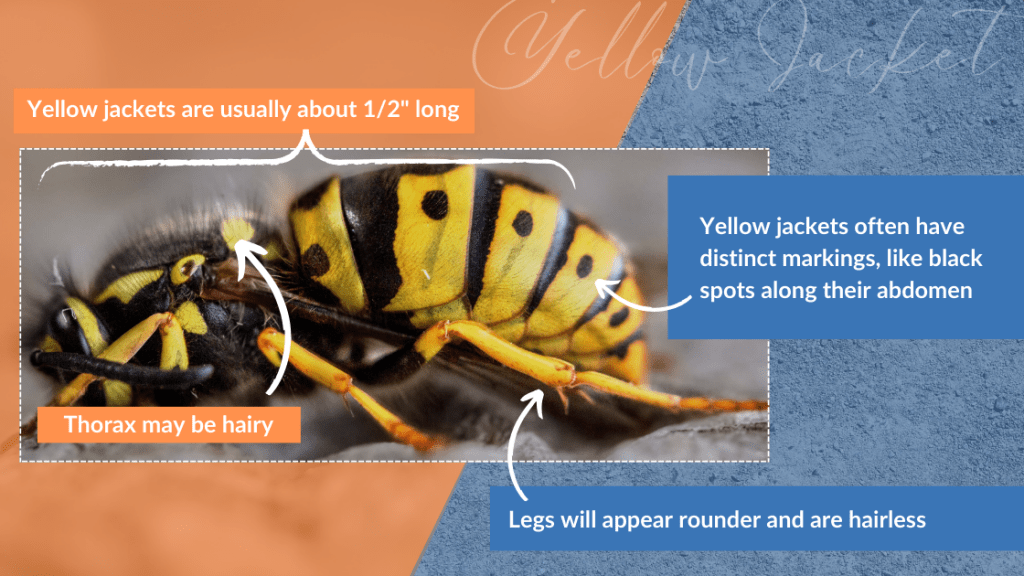
Do they sting?
The short answer: Yes and they bite, too!
Yellow jackets are considered very aggressive and dangerous! They’ll often sting and/or bite unprovoked and they can sting multiple times, which can lead to life-threatening allergic reactions in some people. If you have yellow jackets around your home, you should seek help from an exterminator to remove the infestation ASAP!
Hornets
Unlike yellow jackets, hornets nest above ground in places like bushes and trees. They create their nests by chewing wood from decking, fences, logs, and outdoor play sets to create a pulp-like substance. Nests vary in color depending on what type of wood is used to create it and are often found in shaded areas that provide protection from spring weather.
Hornets eat leaves and tree sap but are also predators like yellow jackets, feeding on flies, bees, and other insects. While they’re not as aggressive as yellow jackets, they’re still considered a dangerous nuisance pest.
What do they look like?
Hornets are similar in appearance to wasps. Like wasps, hornets have black and yellow banding but their coloration will often include reddish-brown hues in addition to that. Their wings especially will be noticeably more gold-brown in color. Hornets bodies are also thicker and more robust than wasps. They are typically larger, sometimes reaching over 2” in length!
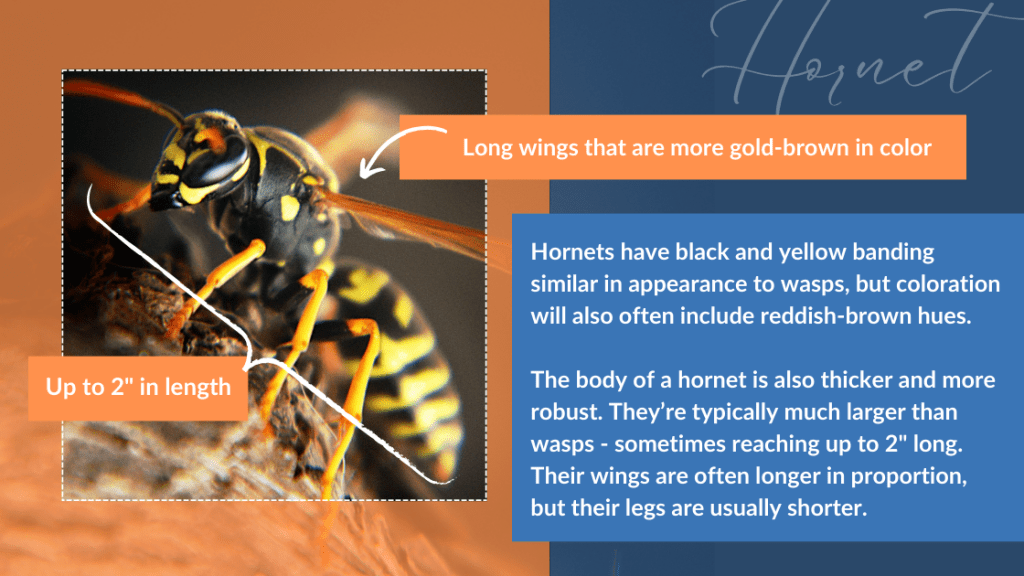
Do they sting?
The short answer: Yes, repeatedly!
Like yellow jackets, they have a smooth stinger so they can sting multiple times. Their stings also contain a venom that can cause life-threatening reactions in some people. As with yellow jackets, if you find hornets around your home, call an exterminator immediately to remove these dangerous pests!
Wasp & Hornet Elimination
Have more questions about the black and yellow striped insects buzzing around your home? Need help removing a nest or dealing with an aggressive wasp or hornet infestation? Give go2-pros pest control a call at (937) 602-2602. Our experienced pest control experts are here to help you identify and eliminate problem pests to ensure your family and pets stay safe.
Honey Bee Relocation
Go2-Pros also helps in relocating more beneficial pests like honey bees, too. Due to the dramatic decline in the honey bee population across the globe, we take special precautions to protect honey bees and their natural habitats. Our treatments are chosen and strategically implemented to avoid impacting our own native honey bee population. If you’re dealing with honey bees, our pest control technicians will work to relocate the problem hive with help from local beekeepers. Give us a call at (937) 602-2602 if you need assistance with the relocation of an active honey bee hive.
